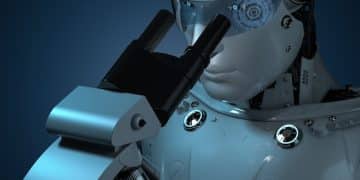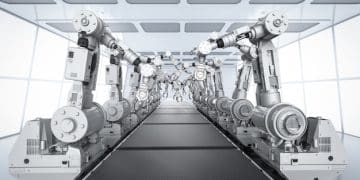Robotics & US Labor Shortage: Can Automation Fill 500K Jobs?
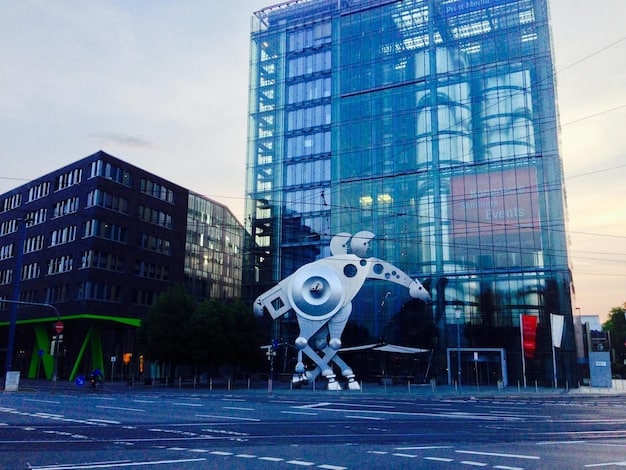
The United States currently faces a significant labor shortage, with projections suggesting a deficit of 500,000 workers across various sectors; advanced robotics and automation technologies are increasingly considered a crucial solution, potentially filling these open positions while redefining the future of work.
The persistent challenge of a significant labor shortage in the United States, exacerbated by demographic shifts and evolving economic landscapes, presents a complex dilemma for industries nationwide. Can automation truly bridge this gap, specifically addressing the critical need for approximately 500,000 workers? This article delves into how Robotics and the US Labor Shortage: Can Automation Fill 500,000 Open Positions? by exploring the capabilities of advanced robotic systems, their integration into diverse sectors, and the broader socio-economic implications of this technological evolution.
The evolving landscape of the US labor market
The US labor market is in a dynamic state, characterized by significant shifts that challenge traditional employment models. A confluence of factors, including an aging workforce, changing immigration policies, and evolving educational attainment, contributes to a persistent labor deficit. This scarcity isn’t uniform; it disproportionately affects sectors such as manufacturing, healthcare, logistics, and hospitality, where demand often outstrips the available talent pool.
The current shortage is more than just a temporary fluctuation; it reflects deep-seated structural changes. Many traditional industries struggle to attract and retain workers for roles often perceived as physically demanding, repetitive, or low-paying. This phenomenon is further complicated by a skills gap, where available workers often lack the specialized training required for emerging high-tech positions, while essential entry-level roles remain unfilled due to a lack of interest or competitive compensation.
Understanding the current deficit
Pinpointing the precise number of unfilled jobs is an ongoing challenge, as data evolves rapidly. However, various analyses from organizations like the US Chamber of Commerce and the Bureau of Labor Statistics consistently point to a deficit exceeding half a million positions across critical sectors. This isn’t just about quantitative figures; it’s about the qualitative impact on economic productivity, supply chain resilience, and the overall competitiveness of American businesses.
- Manufacturing: Experiencing a persistent need for skilled trades, machine operators, and engineers.
- Healthcare: A severe shortage of nurses, doctors, and allied health professionals, intensified by the pandemic.
- Logistics and Supply Chain: Warehouse workers, truck drivers, and last-mile delivery personnel are in high demand.
- Hospitality and Retail: Struggling to fill customer service, food preparation, and sales roles.
These deficits underscore a critical vulnerability in the economic fabric, prompting an urgent search for sustainable solutions. The conversation increasingly turns to technology, specifically robotics and automation, as a potential alleviator of these pressures.
Drivers of the labor shortage
Several underlying forces contribute to the magnitude and persistence of the labor shortage. The aging demographic structure of the US population means fewer young workers are entering the workforce to replace retiring generations. Additionally, shifts in worker preferences, often termed the “Great Resignation” or “Great Reevaluation,” have led many to seek roles offering greater flexibility, better compensation, and more meaningful work, leaving less desirable positions vacant.
The ongoing impact of global events, from supply chain disruptions to geopolitical tensions, also plays a role, influencing migration patterns and the availability of both skilled and unskilled labor. Moreover, an accelerating pace of technological change often outpaces the development of new skills, creating a mismatch between the jobs needing to be done and the capabilities of the readily available workforce.
The rise of robotics and automation in industry
Robotics and automation are no longer confined to the realms of science fiction or niche industrial applications; they are rapidly becoming integral components of modern enterprise. From advanced manufacturing lines to sophisticated logistics hubs, robots are performing tasks with precision, speed, and tireless efficiency that human labor often cannot match, or prefers not to. This technological evolution represents a significant paradigm shift in how work is conceived and executed, offering solutions to long-standing industrial challenges.
The deployment of robots spans a wide spectrum, encompassing everything from traditional industrial manipulators and autonomous mobile robots (AMRs) to collaborative robots (cobots) designed to work alongside humans. These systems are not merely replacing human workers; they are augmenting capabilities, enhancing safety, and opening up entirely new possibilities for productivity and innovation across various sectors.
Different types of robots and their applications
The diversity of robotic solutions is a testament to their adaptability. Industrial robots are the workhorses of manufacturing, welding, painting, assembling, and handling heavy materials. AMRs navigate warehouses autonomously, moving goods and optimizing inventory management. Cobots offer a unique blend of automation and human collaboration, performing repetitive or strenuous tasks while allowing humans to focus on more complex, decision-making roles.
Beyond the factory floor, robots are making inroads into unexpected areas. Service robots assist in hospitality and retail, delivering food, cleaning, and providing customer support. Surgical robots enhance precision in healthcare, while delivery robots are beginning to redefine last-mile logistics. Each type of robot is tailored to specific functions, aiming to address particular pain points within an industry.
Key technological advancements driving adoption
The current surge in robotic deployment is propelled by several interlocking technological advancements. Improved artificial intelligence (AI) and machine learning (ML) capabilities enable robots to learn, adapt, and make more complex decisions in dynamic environments. Enhanced sensor technologies provide robots with better perception, allowing them to navigate intricate spaces and interact safely with their surroundings.
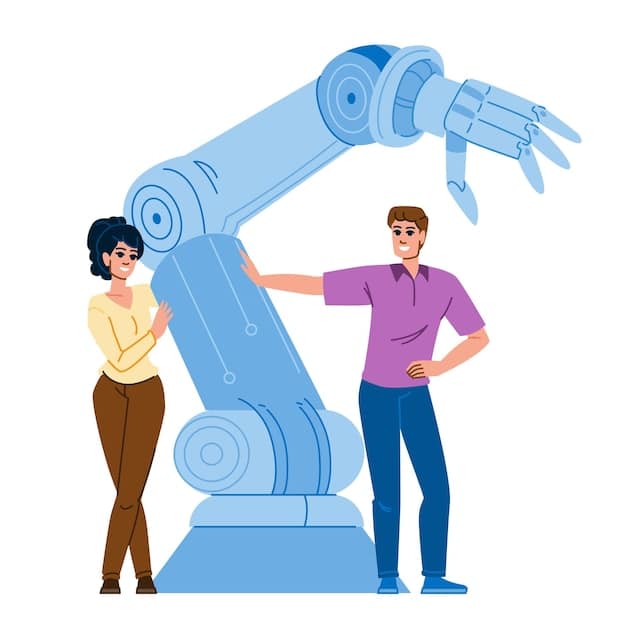
Furthermore, increased processing power, miniaturization, and advancements in battery technology have made robots more versatile, mobile, and capable. The development of user-friendly programming interfaces has also democratized access to robotics, allowing businesses without specialized engineering teams to integrate automation solutions more easily. These innovations collectively reduce costs, improve performance, and expand the range of tasks robots can perform effectively.
Robotics as a solution: addressing the 500,000 job gap
The crucial question remains: can robotics genuinely address the formidable challenge of filling over 500,000 open positions in the US labor market? The emerging consensus among economists and industry experts is that while robots are not a panacea, they represent a powerful, increasingly indispensable tool in mitigating the labor shortage. Their ability to perform repetitive, dangerous, or physically demanding tasks not only frees up human workers for more value-added roles but also addresses the difficulty in attracting human talent to these less desirable jobs.
Automation’s role extends beyond mere replacement; it is transforming the concept of work itself. By assuming tasks historically plagued by high turnover rates or labor scarcity, robots enable businesses to maintain productivity, improve efficiency, and even expand operations in ways that would be impossible with traditional labor models alone. This integration allows companies to meet demand, fulfilling orders, and providing services that would otherwise be constrained by workforce limitations.
Specific sectors where robots can make an impact
The impact of robotics is most apparent in sectors that struggle with severe labor deficits and feature tasks suitable for automation. In manufacturing, robots can handle material loading, machine tending, and quality inspection, directly addressing the shortage of production line workers. In logistics, automated guided vehicles (AGVs) and AMRs can manage warehouse operations, while robotic arms sort packages, easing the burden on human staff and improving the flow of goods.
- Manufacturing: Assembly, welding, painting, material handling, quality control.
- Logistics: Warehouse automation, order fulfillment, last-mile delivery, sorting.
- Healthcare: Dispensing medication, transporting supplies, assisting surgeries, patient monitoring.
- Agriculture: Harvesting, planting, spraying, sorting produce.
- Hospitality: Cleaning, food preparation, guest services, delivery.
These applications demonstrate that robots are not just theoretical solutions; they are already actively deployed, often making a measurable difference in operational capacity and workforce utilization. Their presence allows human workers to pivot to more supervisory, analytical, or customer-facing roles, enhancing overall service quality and job satisfaction.
Case studies and successful implementations
Numerous companies across the US have successfully integrated robotics to address their labor challenges. For instance, major e-commerce retailers rely heavily on robotic fulfillment centers, where fleets of robots retrieve and sort packages, enabling rapid order processing that would be impossible with human-only labor. Automotive factories have long utilized robotic arms for precision welding and assembly, creating safer and more efficient production lines.
In smaller-scale examples, restaurants are experimenting with robotic chefs for repetitive tasks like frying or baking, while hotels are deploying cleaning robots to assist housekeeping staff. These real-world applications underscore that robotics is not just a concept but a practical, deployable solution actively filling critical functional gaps in a tight labor market. The success stories provide a blueprint for other businesses contemplating similar automation strategies.
Challenges and considerations for widespread adoption
While the potential of robotics to alleviate the US labor shortage is significant, its widespread adoption is not without considerable challenges and requires careful consideration. The integration of advanced automation systems involves more than simply plugging in machines; it necessitates a complex interplay of capital investment, workforce retraining, ethical considerations, and strategic planning. Overlooking these factors could lead to suboptimal outcomes, or even exacerbate existing economic disparities rather than solving them.
One primary hurdle is the initial cost. Investing in robotics can be substantial, often requiring significant upfront capital for hardware, software, and infrastructure modifications. This can be a deterrent for small and medium-sized enterprises (SMEs) that operate on tighter margins, even if the long-term return on investment is promising. Beyond the purely financial aspect, there are operational complexities involved in integrating robots into existing workflows, ensuring seamless communication between human and machine, and maintaining these sophisticated systems.
Economic implications and required investments
The economic ramifications of widespread robotic adoption extend beyond direct costs. There’s the need for new infrastructure, energy consumption, and the development of a robust support ecosystem for robotics maintenance and repair. Businesses must analyze the total cost of ownership, including deployment, training, energy, and ongoing maintenance, against the potential savings from reduced labor costs and increased productivity.
Furthermore, the investment cycle can be lengthy, with returns materializing over several years. This requires businesses to have a clear long-term strategy and access to capital for sustained investment in automation. Government incentives, tax breaks, and grants could play a crucial role in encouraging broader adoption, particularly for industries vital to national security or economic competitiveness.
Workforce retraining and ethical considerations
Perhaps the most significant challenge lies in the human element. While robots may fill specific job roles, they also necessitate a profound transformation of the existing workforce. Many jobs will be augmented or eliminated, requiring extensive retraining and upskilling programs to prepare workers for new, often more technologically advanced, roles. This workforce transition demands collaboration between government, educational institutions, and businesses to develop relevant curricula and facilitate smooth career shifts.
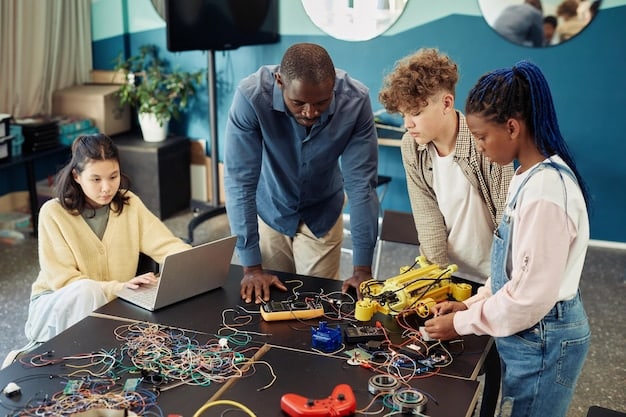
Ethical considerations are also paramount. Concerns about job displacement, the equitable distribution of automation benefits, and the potential for a widening wealth gap must be addressed proactively. Society needs to grapple with questions of universal basic income, social safety nets, and ensuring that the benefits of increased productivity are shared broadly, rather than concentrated among a select few. The goal should be to create a symbiotic relationship between humans and robots, where technology serves to enhance human potential and well-being.
Regulatory hurdles and safety standards
The rapid evolution of robotics also presents challenges for regulatory bodies and the development of appropriate safety standards. As robots become more autonomous and interactive, new rules and guidelines are needed to ensure their safe operation, protect human workers, and address potential liabilities. Establishing clear, consistent, and adaptable regulatory frameworks is essential for fostering innovation while safeguarding public interest.
International cooperation on safety standards and ethical guidelines for AI and robotics will also be vital to ensure a level playing field and prevent regulatory fragmentation. Balancing the need for rapid deployment with thorough safety protocols is a delicate act that requires ongoing dialogue between industry, government, and civil society. Ignoring these regulatory facets could impede adoption or, worse, lead to unforeseen negative consequences.
The future of work: human-robot collaboration and new roles
The integration of robotics into the US economy will not simply eliminate jobs; it will fundamentally reshape the nature of work itself. Rather than a stark dichotomy of human versus machine, the future envisions a more collaborative ecosystem where humans and robots work side-by-side, each leveraging their unique strengths. This shift will necessitate a redefinition of skills, job roles, and even the organizational structures of businesses, leading to an exciting new era of productivity and innovation.
The focus will increasingly shift from manual labor to tasks requiring critical thinking, problem-solving, creativity, emotional intelligence, and complex project management—areas where humans currently hold a significant advantage. Routinely, repetitive tasks will be delegated to machines, freeing human workers to concentrate on higher-level functions, strategic initiatives, and personalized interactions that demand human empathy and judgment.
Emerging job roles in a roboticized economy
The rise of robotics is not just about job displacement; it’s also about job creation. New roles are emerging that are directly linked to the design, deployment, maintenance, and oversight of robotic systems. These include:
- Robot technicians and engineers: Specialists responsible for the installation, programming, and repair of robotic systems.
- AI and machine learning specialists: Developing the algorithms and intelligence that power autonomous robots.
- Data scientists: Analyzing the vast amounts of data generated by robotic systems to optimize performance and identify new opportunities.
- Human-robot interaction designers: Focusing on how humans and robots can work together seamlessly and intuitively.
- Ethicists and policy makers: Guiding the responsible development and deployment of AI and robotics within societal bounds.
These roles often require interdisciplinary skills, blending technical expertise with strong capabilities in communication, collaboration, and adaptive learning. Educational systems will need to evolve rapidly to prepare the workforce for these new demands, emphasizing STEM fields, critical thinking, and continuous learning.
The concept of human-robot collaboration (HRC)
Human-robot collaboration (HRC), often featuring “cobots,” represents a key aspect of the future of work. Cobots are designed to work safely alongside humans, sharing workspaces and tasks without the need for extensive safety cages. This allows for a flexible division of labor: robots handle repetitive, precise, or strenuous tasks, while humans focus on activities requiring dexterity, judgment, or creativity.
For example, a cobot might hold a heavy component in place while a human employee performs a delicate assembly task. In logistics, a human worker might pick items from shelves guided by an AMR. This collaborative model enhances productivity and safety, reduces physical strain on human workers, and allows businesses to scale operations without necessarily relying on an ever-expanding human workforce to do every task.
Policy and educational initiatives for a seamless transition
To ensure a smooth transition into this roboticized future, proactive policy and educational initiatives are crucial. Governments can implement policies that encourage businesses to invest in automation while also supporting workforce development programs. This includes funding for vocational training, apprenticeships, and lifelong learning platforms focused on digital literacy, AI, and robotics skills.
Educational institutions at all levels—from K-12 to universities and community colleges—must adapt their curricula to emphasize STEM subjects, coding, and problem-solving. Partnerships between academia and industry can ensure that training programs are aligned with the skills demanded by emerging job roles. Furthermore, initiatives that provide social safety nets and unemployment benefits during periods of transition can help mitigate the immediate impact of job displacement and foster public acceptance of automation.
Ethical implications and societal impact
Beyond the economic calculus, the widespread adoption of robotics and automation carries profound ethical implications and a significant societal impact that must be carefully navigated. The transformation of the labor market, while potentially solving the immediate problem of labor shortages, also raises deeper questions about equity, access, and the very definition of human contribution in an increasingly automated world. Addressing these concerns proactively is essential for ensuring that technological progress benefits all segments of society, rather than exacerbating existing disparities.
One undeniable ethical challenge is the potential for job displacement, particularly for those in roles involving routine or manual tasks. While new jobs will undoubtedly be created, there is a risk that the transition period could leave a portion of the workforce behind, especially those without access to retraining or education in emerging fields. This could lead to increased unemployment in certain sectors, widening the gap between highly skilled and less skilled workers, and potentially increasing social inequality.
Ensuring equitable access and benefits
A key ethical imperative is to ensure that the benefits of automation are distributed equitably across society. This includes providing accessible opportunities for upskilling and reskilling to all workers, regardless of their current socioeconomic status or educational background. Public investment in education and vocational training focused on robotics, AI, and related technologies will be critical to empowering individuals to transition into future-proof roles.
Furthermore, discussions about innovative economic models, such as universal basic income (UBI) or worker ownership of automated systems, may become more prominent as productivity gains from automation become more widespread. The goal must be to create a society where everyone has the opportunity to thrive, even as the nature of work fundamentally changes. This requires a strong commitment from policymakers, industry leaders, and civil society organizations to foster inclusive growth.
Addressing job displacement and socio-economic disparities
The potential for job displacement demands a multi-faceted approach. Beyond retraining, governments and corporations need to consider transition support for workers whose jobs are automated, which could include extended unemployment benefits, relocation assistance, and career counseling services. It’s also crucial to identify and support vulnerable communities that might be disproportionately affected by automation, ensuring they have the resources needed to adapt.
Policymakers must also consider how to leverage automation to create higher-value jobs within existing industries, rather than solely focusing on entirely new sectors. For example, robots can take over dangerous tasks, allowing human workers to supervise, maintain, and optimize these automated systems, thus elevating their roles and contributing to a safer work environment. This proactive strategy aims to minimize negative social impacts and foster a more resilient workforce.
The role of government and industry in guiding ethical automation
Both government and industry have a critical role to play in guiding the ethical development and deployment of automation. Governments can establish regulatory frameworks that promote fair labor practices, ensure data privacy, and address issues of algorithmic bias in AI-driven robotic systems. They can also fund research into the societal impacts of automation and develop policies that encourage responsible innovation.
Industry leaders, in turn, have a responsibility to develop and deploy automation technologies with a keen awareness of their societal implications. This means prioritizing human-centric design, investing in their workforces’ upskilling, and actively participating in dialogues about the future of work. Adopting ethical AI principles and incorporating social impact assessments into technology development are crucial steps. A collaborative approach, involving all stakeholders, will be necessary to navigate these complex ethical landscapes and ensure a future where automation serves humanity’s best interests.
Conclusion
| Key Aspect | Brief Description |
|---|---|
| 🤖 Labor Gap | The US faces a significant shortage, potentially 500,000 workers, across vital sectors like manufacturing and healthcare. |
| 🚀 Robotics Potential | Automation helps fill roles requiring repetitive or physically demanding tasks, enhancing productivity and safety. |
| 💰 Investment & Training | Significant capital investment and extensive workforce retraining are crucial for broad robotic adoption. |
| 🤵⚕️ Future & Ethics | Focus on human-robot collaboration, new job creation, and ethical oversight to ensure equitable societal benefits. |
Frequently Asked Questions about Robotics and the Labor Shortage
▼
Yes, multiple sources, including the US Chamber of Commerce, indicate a substantial and persistent labor shortage across various sectors. Estimates suggest a deficit of over 500,000 workers in critical industries like manufacturing, healthcare, and logistics, impacting economic productivity and supply chain stability. This shortage is driven by factors such as an aging workforce and evolving worker preferences.
▼
Robots can fill existing vacancies by taking over repetitive, physically demanding, or dangerous tasks that human workers often avoid or for which there is a short supply of labor. This includes roles in manufacturing (e.g., assembly), logistics (e.g., sortation), and even healthcare (e.g., material transport). By automating these specific functions, robots free up humans for more complex, interpersonal, or supervisory roles, thereby addressing the deficit.
▼
Widespread robotic adoption faces challenges such as high initial capital investment for businesses, the need for extensive workforce retraining to adapt to new roles, and navigating ethical concerns regarding job displacement. Additionally, developing robust regulatory frameworks and ensuring seamless human-robot collaboration are complexities that require careful planning and strategic execution.
▼
Absolutely. While some jobs may be automated, robotics is expected to create new roles focused on the design, development, deployment, maintenance, and ethical oversight of robotic systems. These include positions like robot technicians, AI and machine learning specialists, data scientists, and human-robot interaction designers. The future workforce will require new skills centered around technology, creativity, and problem-solving.
▼
Human-robot collaboration (HRC) involves humans and robots working side-by-side in a shared workspace, often using “cobots” (collaborative robots). This model allows robots to handle tasks suited for automation (e.g., heavy lifting, repetitive motions) while humans focus on activities requiring dexterity, cognitive decision-making, or interpersonal skills. HRC aims to boost productivity, improve safety, and enhance job satisfaction for human workers.
Conclusion
The US labor shortage is a complex challenge with deep roots, demanding innovative solutions beyond conventional approaches. While not a singular remedy, robotics and automation offer a compelling and increasingly viable pathway to bridge the estimated 500,000 open positions across critical sectors. The strategic integration of robots can enhance productivity, improve safety, and ensure operational continuity where human labor is scarce, shifting the human role towards oversight, innovation, and value-added tasks. However, realizing this potential requires significant investment in technology, proactive policies for workforce retraining, and a commitment to addressing the ethical implications of automation. The future of work is likely to be defined by a collaborative ecosystem where humans and machines complement each other’s strengths, demanding a forward-thinking approach from industry, government, and educational institutions to ensure a prosperous and inclusive transition.

